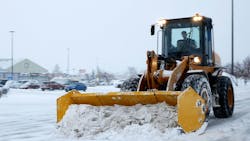As winter approaches, facility and property managers must proactively prepare their grounds for the coming snow and ice. Winter maintenance planning is critical. Experts note that in cold climates, a snow removal and de-icing plan should be in place well before the first storm hits.
Preseason Inspection and Cleanup
Begin preparation by walking every outdoor area to address potential hazards. Inspect parking lots and walkways for potholes, cracked pavement, or uneven concrete, and repair them immediately. Check the lights and visibility of parking lots and entranceways at night. Make sure fallen leaves and debris are cleared from gutters and drains; even a small clog can cause a flood, and pooled water will later freeze into dangerous ice.
Identify any areas that tend to collect water so you can either level out those areas or apply extra salt as needed. Also survey trees and large shrubs. The fall is a good time to remove or prune any weak, dead, or overhanging branches so they don’t break under winter snows.
Protecting Landscaping and Vegetation
Fall tasks like mulching and pruning help landscapes survive winter’s stress. Lay down a 2- to 3-inch layer of fresh mulch over planting beds. Mulch conserves soil moisture, suppresses weeds, and even cools root systems, enhancing plant health through winter.
Trim ornamental shrubs and perennials now. Pruning evergreen shrubs in autumn helps them hold their shape during the snowy months. Cover or insulate any sensitive plants or newly planted turf to prevent freeze damage.
Before the first freeze, be sure to shut off and winterize irrigation systems to avoid burst pipes. By completing these landscaping chores now, you protect your grounds and simplify spring regrowth.
Snow Removal and Deicing Strategies
Snow and ice removal often requires professional crews and a solid plan. Contracting with a reputable snow removal company early is the best way to keep lots and walkways clear. Just be sure to map out every aspect of the plan of execution ahead of time.
Prepare arrangements for crew sizes and specific equipment needs in advance so there are no questions when the first storm hits. Draft and distribute your winter communication tree in-house along with this.
Who notifies tenants, updates signage, locks off unsafe areas, or posts updates on access points? Fall is also the best time to test internal communication tools and prepare pre-written messages or alert templates.
Even with a contract, it’s always wise to maintain on-site preparedness as well. There are horror stories of snow removal companies not showing up or having an understaffed site.
Ensure you have shovels, portable snow blowers, and salt handy for quick touch-ups, especially at building entrances during storms.
Simply moving snow isn’t enough. Icy surfaces still pose hazards. Plan where you will apply deicing agents or salt to roads, ramps, and steps both during and after storms to prevent slick spots. Many commercial operators now use engineered ice-melt or brine mixtures that reduce corrosion while still preventing ice formation. If this is preferred, be sure to make this a part of your snow contract.
It’s important to follow accessibility laws as well. All curb ramps, accessible parking spaces and handicap access aisles must be kept free of snow and ice, and snow cannot be piled so it blocks an accessible path. Make sure these locations are clearly marked on the snow removal plan.
Curb, Pavement, and Hardscape Marking
Before winter settles in, commercial property managers should thoroughly map and physically mark all hardscape edges. Curbs, islands, steps, drainage grates, fire hydrants, and low walls should be equipped with durable, weather-resistant markers. Industry best practices recommend installing fiberglass snow stakes in late fall—ideally, before the ground freezes—to ensure crews hit firm ground and can insert markers easily.
These 26- to 36-inch flexible poles, often topped with reflective tape, are designed to stay visible above the snow line while resisting breakage when accidentally hit by plows.
Set the markers about 6 to 12 inches away from pavement edges. This spacing allows snow to bank up without burying the marker and protects curbs and turf from plow damage.
Maintain consistent intervals of 10 to 15 feet along straight edges for clear guidance, and install extra stakes on curves or around tight corners for enhanced visibility and safety.
In addition, inspect and refresh painted curb lines and fire lanes in fall, when temperatures are still conducive to proper curing. Bright, fresh markings combined with reflective staking guide snow contractors and on-site staff, making it much easier to maintain safe navigation throughout the winter. This visibility-first strategy reduces costly concrete damage, preserves landscape integrity, and ensures plow operators can work efficiently.
Equipment Readiness and Training
If you have your own snow equipment, ensure all snow removal equipment is in top shape ahead of winter. Service plow trucks and salt spreaders, check snow-blower engines, and stock spare fuel, blades, and sandbags.
Verify that you have enough salt and deicing materials on hand. Train staff or contractors in safe winter operations. This should be done annually with a full day of snow removal training covering plow safety, ice management, and sidewalk clearing techniques. When equipment is well maintained and crews are trained, you’ll clear snow faster and reduce accidents during the season.
Preparing for winter is a team effort. By planning ahead, fixing pre-existing problems, protecting plants, and having solid snow and ice removal procedures, managers can keep their grounds safe and functional all winter long. Thorough preparation not only avoids expensive repairs, it also minimizes slip-and-fall risks and keeps tenants and visitors happy. With these measures in place, property professionals can weather the snowy season with confidence.
About the Author
Tom Marsan
Tom Marsan is a certified snow professional who has been in the landscaping and snow removal industry for about two decades. He is an active member of ILCA and SIMA and is currently the General Manager at Beverly Companies in Chicagoland.

